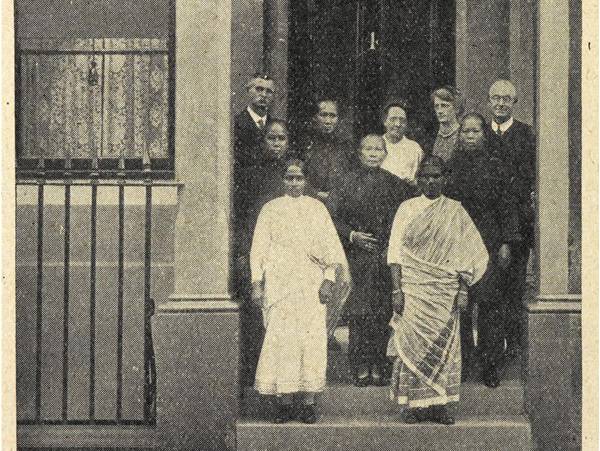
This photograph documents the relocation of the Ayahs’ Home from 26 King Edward Road, Hackney to a larger property at number 4 in 1921. The three relocations throughout the Ayahs’ Home’s history signifies a growing demand for shelter for deserted ayahs in London, with number 4 accommodating 80–223 women per year in its 30 rooms.
Ayahs were employed by British families to look after their children on the sea voyage home. On arrival in Britain, the women were often discharged and left to find their own passage back to India. Such mistreatment led to the setting up of the Ayahs’ Home, run by the London City Mission. The Home provided accommodation for ayahs awaiting their return engagement, as well serving as a refuge for ill-treated and stranded ayahs.
In this photograph are six ayahs who reveal a ‘cross-section’ of the women from India, China and other countries who worked in this capacity. Within the Home itself, women were segregated along these lines – with ticketed bedrooms according to home nation.
The other four people in the background are those responsible for housing the ayahs, in their involvement with the London City Mission as fundraisers, committee members, or matrons.
The Home typically had two strands of income. The first relied upon the ayah’s return ticket, which the returning family surrendered to the matron on the ayah’s arrival to the home – this would then be sold onto another family who were in need of the ayah’s service when departing for India. The second was a system of donations from local church communities. The money obtained from these systems would provide the ayah with ‘free’ board and lodging, costing the London City Mission an average of 14 shillings per week. SOURCE: Rozina Visram, Asians in Britain: 400 Years of History (London, 2002).
Ayahs were employed by British families to look after their children on the sea voyage home. On arrival in Britain, the women were often discharged and left to find their own passage back to India. Such mistreatment led to the setting up of the Ayahs’ Home, run by the London City Mission. The Home provided accommodation for ayahs awaiting their return engagement, as well serving as a refuge for ill-treated and stranded ayahs.
In this photograph are six ayahs who reveal a ‘cross-section’ of the women from India, China and other countries who worked in this capacity. Within the Home itself, women were segregated along these lines – with ticketed bedrooms according to home nation.
The other four people in the background are those responsible for housing the ayahs, in their involvement with the London City Mission as fundraisers, committee members, or matrons.
The Home typically had two strands of income. The first relied upon the ayah’s return ticket, which the returning family surrendered to the matron on the ayah’s arrival to the home – this would then be sold onto another family who were in need of the ayah’s service when departing for India. The second was a system of donations from local church communities. The money obtained from these systems would provide the ayah with ‘free’ board and lodging, costing the London City Mission an average of 14 shillings per week. SOURCE: Rozina Visram, Asians in Britain: 400 Years of History (London, 2002).

